Trumpet Custom and Replacement Parts
-
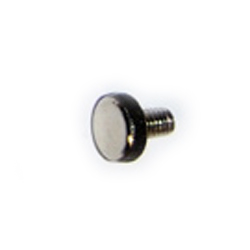
-
Bach
Thumb Screw, Knurled
This knurled thumb screw is used on a number of Bach, Bundy, Selmer and other trumpets, cornets, flugelhorns, french horns, bassoons, and bass trombones, for a variety of purposes:• Trumpet 3rd Valve Rings
• Bass Trombone 2nd Valve Finger Lever Spatulas
• Trumpet Triggers
• Lyre Mounts
Category: Trumpet Replacement Parts
Item: 109285
Grade:
List Price: $16.00
OUR PRICE: $10.45
Availability: Usually Ships in 24 Hours - View Shopping Cart
-
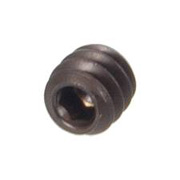
-
Bach
Trumpet 3rd Valve Slide Set Screw
Set screw to lock in the threaded rod on the third slide stop mechanism. Requires a small hex wrench (allen key) to tighten (not included).
Category: Trumpet Replacement Parts
Item: 070938
Grade:
List Price: $2.20
OUR PRICE: $1.89
Availability: Usually Ships in 24 Hours - View Shopping Cart
-
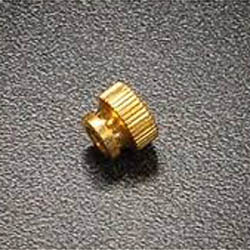
-
Bach
Trumpet 3rd Valve Slide Stop Nut - gold plated
Gold plated stop nut for use on Bach Centennial, Anniversary and other trumpets with gold plated trim.
Category: Trumpet Replacement Parts
Item: 123312
Grade:
List Price:
OUR PRICE: $12.00
Availability: Usually Ships in 24 Hours - View Shopping Cart
-
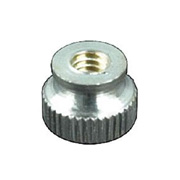
-
Bach
Trumpet 3rd Valve Slide Stop Nut - nickel plated
Single "knurl nut" for Bach Stradivarius trumpet 3rd valve slides. These nuts (always used as a pair, bearing against one another) are used to prevent the third valve slide from falling off the horn. The nuts (one or both) are commonly lost. These replace the factory originals. Sold as a single nut. If you need a pair, please order two. -cdp
Category: Trumpet Replacement Parts
Item: 066910
Grade:
List Price:
OUR PRICE: $4.79
Availability: Usually Ships in 24 Hours - View Shopping Cart
-

-
Bach
Trumpet 3rd Valve Slide Stop Nut - silver plated
Single "knurl nut" for Bach Stradivarius trumpet 3rd valve slides. These nuts (always used as a pair, bearing against one another) are used to prevent the third valve slide from falling off the horn. The nuts (one or both) are commonly lost. These replace the factory originals. Sold as a single nut. If you need a pair, please order two. -cdp
Category: Trumpet Replacement Parts
Item: 066909
Grade:
List Price: $6.70
OUR PRICE: $6.00
Availability: Usually Ships in 24 Hours - View Shopping Cart
-
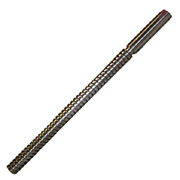
-
Bach
Trumpet 3rd Valve Slide Stop Rod - silver plated
Threaded rod (only) for third valve slide stop mechanism on Bach 180 series Stradivarius trumpets (i.e. models 37, 43, 72, etc.). Silver plated. Set screw and stop nuts sold separately: • Set Screw - 070938 • Stop Nut - 066909 (silver plated) • Stop Nut - 066910 (nickel plated) ...
Read More
Category: Trumpet Replacement Parts
Item: 072541
Grade:
List Price:
OUR PRICE: $7.00
Availability: Usually Ships in 24 Hours - View Shopping Cart
-
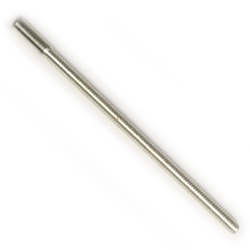
-
Bach
Trumpet 3rd Valve Slide Stop Rod, Long/Artisan - silver plated
Threaded rod (only) for third valve slide stop mechanism on Bach AB180 series Artisan Stradivarius trumpets. This rod is longer than the standard 180 Stradivarius series rod, allowing low F to be performed more cleanly. Silver plated. Set screw and stopnuts are sold separately: • Set Screw - 070938 • Stop Nut - 066909 (silver plated) • Stop Nut - 066910 (nickel plated) ...
Read More
Category: Trumpet Replacement Parts
Item: 091954
Grade:
List Price: $6.00
OUR PRICE: $5.30
Availability: Usually Ships in 24 Hours - View Shopping Cart
-

-
Bach
Trumpet Bottom Valve Cap - nickel plated
Standard bottom cap for use on lacquered (non-silver plated) Bach Artisan, Stradivarius and TR200 series trumpets. Sold as a single unit. To replace all three caps, please order three pieces.
Category: Trumpet Replacement Parts
Item: 112086
Grade:
List Price:
OUR PRICE: $11.95
Availability: Usually Ships in 24 Hours - View Shopping Cart
-

-
Bach
Trumpet Bottom Valve Cap - silver plated
Standard bottom cap for use on Bach Artisan, Stradivarius and TR200 series silver plated trumpets. Sold as a single unit. To replace all three caps, please order three pieces.
Category: Trumpet Replacement Parts
Item: 112087
Grade:
List Price: $13.20
OUR PRICE: $10.99
Availability: Usually Ships in 24 Hours - View Shopping Cart
-
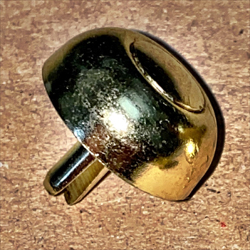
-
Bach
Trumpet Case Foot for 190 Case
Original equipment replacement brass foot for Bach model 190 trumpet cases and other similar models. Sold singly. If you need more than one, order additional pieces as required.
Category: Trumpet Replacement Parts
Item: 119489
Grade:
List Price:
OUR PRICE: $2.00
Availability: Usually Ships in 24 Hours - View Shopping Cart
-

-
Bach
Trumpet Finger Button - nickel silver
Replacement finger button for Bach Stradivarius and Bach TR200 series trumpets. Nickel-silver lacquered finish. Original equipment factory replacement part. Threads onto valve stem. Single button. If you want to replace all three, please order three.
Category: Trumpet Replacement Parts
Item: 117064
Grade:
List Price: $19.00
OUR PRICE: $12.45
Availability: Ships in 20 to 30 Days - View Shopping Cart
-

-
Bach
Trumpet Finger Button - silver plated
***PLEASE NOTE that this item has been out of stock at the supplier and is going to take longer than usual to arrive. Current eta is the end of November. This is not a guarantee, but likely. ***Replacement finger button for Bach Stradivarius and TR200 series trumpets. Silver plated finish with synthetic ivories. Original equipment factory replacement part. Threads onto valve stem. Single button. If you want to replace all three, please order three.
Category: Trumpet Replacement Parts
Item: 117063
Grade:
List Price: $23.00
OUR PRICE: $19.25
Availability: Usually Ships in 24 Hours - View Shopping Cart
-

-
Bach
Trumpet Finger Button Felt Washer
Felt bumper washer that goes on the valve stem below the finger button and acts as a cushion when pressing the valve. Sold as a single felt, if you are replacing all three, please order three.• approx 14mm wide
• approx 2.75mm thick
• approx 3.5mm opening
Category: Trumpet Replacement Parts
Item: 075257
Grade:
List Price: $2.00
OUR PRICE: $1.59
Availability: Ships in 10 to 15 Days - View Shopping Cart
-
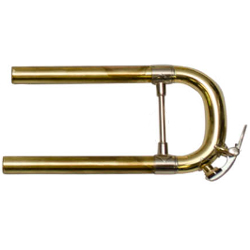
-
Bach
Trumpet Main Tuning Slide Assembly, ML Bore - lacquer
Main tuning slide assembly for all Bach 180 series trumpets with ML bores (37, 43, and 72).
Category: Trumpet Replacement Parts
Item: 138744
Grade:
List Price: $339.00
OUR PRICE: $314.95
Availability: Ships in 10 to 15 Days - View Shopping Cart
-
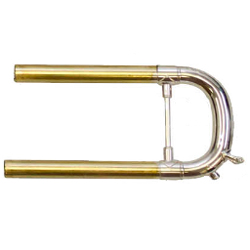
-
Bach
Trumpet Main Tuning Slide Assembly, ML Bore - silver plate
Main tuning slide assembly for all Bach 180 series trumpets with ML bores (37, 43, and 72).
Category: Trumpet Replacement Parts
Item: 138745
Grade:
List Price: $471.00
OUR PRICE: $429.95
Availability: Ships in 10 to 15 Days - View Shopping Cart
-

-
Bach
Trumpet Valve Bumper
Rubber ring bumper washer goes inside the bottom valve cap and provides cushioning and noise reduction for the descending piston. Sold singlely. If you plan to replace all three, please order three.
Category: Trumpet Replacement Parts
Item: 075258
Grade:
List Price: $2.40
OUR PRICE: $1.60
Availability: Usually Ships in 24 Hours - View Shopping Cart
-

-
Bach
Trumpet Valve Guide
Replacement plastic valve guide for Bundy model 1530 trumpets and 1531 cornets, Bach 300-series student level trumpets, and Bach 200-series flugelhorns. Will NOT fit 200-series Bach trumpets or any other professional level instruments. Sold individually.If you need three, order three.
Category: Trumpet Replacement Parts
Item: 081832
Grade:
List Price:
OUR PRICE: $2.00
Availability: Usually Ships in 24 Hours - View Shopping Cart
-
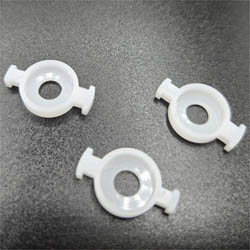
-
Bach
Trumpet Valve Guides, Plastic [3-pack]
Plastic valve guides fit all Bach Stradivarius, Artisan, and TR200 series trumpets. Does NOT fit student level Tr300 series instruments. Set of 3 guides.
Category: Trumpet Replacement Parts
Item: 126634
Grade:
List Price: $6.40
OUR PRICE: $6.00
Availability: Usually Ships in 24 Hours - View Shopping Cart
-
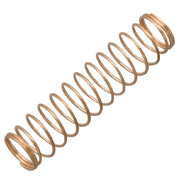
-
Bach
Trumpet Valve Spring for Bach 200 & 300 Series
Factory replacement valve spring. One spring. Replacement for Bach trumpet, cornet and flugelhorns of the 200 & 300/310 series and others, including model 181 and 184 cornets, 843 valve trombone, Bach Mercedes II trumpet, and Bundy 1530 trumpet & 1531 cornet.
Category: Trumpet Replacement Parts
Item: 072784
Grade:
List Price: $4.95
OUR PRICE: $3.95
Availability: Ships in 10 to 15 Days - View Shopping Cart
-

-
Bach
Trumpet Valve Springs for Bach 180 Series [set of 3]
Factory replacement valve springs for all Stradivarius and Artisan trumpets. Set of three springs.NOTE: Image shown is generic and may not accurately represent this exact item.
Category: Trumpet Replacement Parts
Item: 072783
Grade:
List Price: $5.99
OUR PRICE: $4.80
Availability: Usually Ships in 24 Hours - View Shopping Cart
-

-
Bach
Trumpet Valve Stem - gold plated [each]
Gold plated valve stem replaces your existing OEM stem. Fits Bach Stradivarius trumpets and cornets. Sold individually. If you want to replace all three, please order three.
Category: Trumpet Replacement Parts
Item: 130262
Grade:
List Price:
OUR PRICE: $12.00
Availability: Ships in 10 to 15 Days - View Shopping Cart
-

-
Bach
Trumpet Valve Stem - gold plated [each]
Gold plated valve stem replaces your existing OEM stem. Fits Bach Stradivarius trumpets and cornets. Sold individually. If you want to replace all three, please order three.
Category: Trumpet Replacement Parts
Item: 130262
Grade:
List Price:
OUR PRICE: $12.00
Availability: Ships in 10 to 15 Days - View Shopping Cart
-

-
Bach
Trumpet Water Key - Nickle Plate
Bach Waterkey (Water Key) for Stadivarius trumpets (180 and 190 series). This one is nickel plated.
Category: Trumpet Replacement Parts
Item: 130344
Grade:
List Price:
OUR PRICE: $34.95
Availability: Ships in 10 to 15 Days - View Shopping Cart
-

-
Bach
Trumpet Water Key - Silver Plate
Bach Waterkey (Water Key) for Stadivarius trumpets (180 and 190 series). This one is silver plated.
Category: Trumpet Replacement Parts
Item: 130345
Grade:
List Price: $78.00
OUR PRICE: $61.95
Availability: Ships in 10 to 15 Days - View Shopping Cart
-

-
Bach
Trumpet Water Key Screw - Nickel Plate
Waterkey screw in Nickel plate for Bach 180 and 190 series Stradivarius trumpets.
Category: Trumpet Replacement Parts
Item: 130347
Grade:
List Price:
OUR PRICE: $6.50
Availability: Ships in 10 to 15 Days - View Shopping Cart
-

-
Bach
Trumpet Water Key Screw - Silver Plate
Silver plated waterkey screw suitable for Bach 180 and 19- series trumpets.
Category: Trumpet Replacement Parts
Item: 130346
Grade:
List Price: $11.90
OUR PRICE: $9.95
Availability: Ships in 10 to 15 Days - View Shopping Cart
-
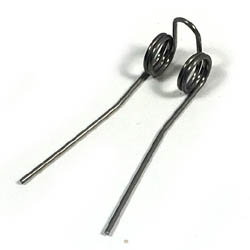
-
Bach
Trumpet Water Key Spring
Factory replacement spring for traditional water keys on all Bach Stradivarius model trumpets. This is a medium-weight 1/32 inch 2-3 winding spring with a 7/16-inch round nose (measured from base of spring coil to tip of nose) and a 3/16-inch opening. Not for use on Amado water keys. 1 spring. Clip tails after installation.
Category: Trumpet Replacement Parts
Item: 062070
Grade:
List Price:
OUR PRICE: $2.50
Availability: Ships in 14 to 21 Days - View Shopping Cart
-

-
Bach
Valve Stem
Factory original all-aluminum valve stem for use on all Bach Stradivarius trumpets (all keys) and cornets, as well as intermediate (200 series) and student (300 series) instruments. Sold individually (if you need all 3, please order 3).
Category: Trumpet Replacement Parts
Item: 135616
Grade:
List Price: $8.80
OUR PRICE: $7.45
Availability: Ships in 10 to 15 Days - View Shopping Cart
-
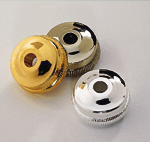
-
Bach 1810
Trumpet Valve Caps, Heavy - lacquer
For use on Bach Stradivarius trumpets. Precision machined from nickel silver, with twice the mass and twice the weight of standard bottom valve caps, Bach heavy valve caps dampen vibrations. The result is a warmer, more powerful sound that is perfect forthe concert hall, studio and club alike.
Category: Trumpet Replacement Parts
Item: 044378
Grade:
List Price: $48.00
OUR PRICE: $34.99
Availability: Usually Ships in 24 Hours - View Shopping Cart
-

-
Bach 1810G
Trumpet Valve Caps, Heavy - gold plated
For use on Bach Stradivarius trumpets. Precision machined from nickel silver, with twice the mass and twice the weight of standard bottom valve caps, Bach heavy valve caps dampen vibrations. The result is a warmer, more powerful sound that is perfect forthe concert hall, studio and club alike.
Category: Trumpet Replacement Parts
Item: 044380
Grade:
List Price: $113.00
OUR PRICE: $83.95
Availability: Ships in 60 to 90 Days - View Shopping Cart
-

-
Bach 1810S
Trumpet Valve Caps, Heavy - silver plated
For use on Bach Stradivarius trumpets. Precision machined from nickel silver, with twice the mass and twice the weight of standard bottom valve caps, Bach heavy valve caps dampen vibrations. The result is a warmer, more powerful sound that is perfect forthe concert hall, studio and club alike.
Category: Trumpet Replacement Parts
Item: 044379
Grade:
List Price: $55.00
OUR PRICE: $34.95
Availability: Usually Ships in 24 Hours - View Shopping Cart
-

-
Besson Sovereign
Cornet Water Key Spring
OEM water key spring for the Sovereign Cornet. Also works on the B&S trumpet third valve slide.
Category: Trumpet Replacement Parts
Item: 118955
Grade:
List Price:
OUR PRICE: $3.99
Availability: Usually Ships in 24 Hours - View Shopping Cart
-

-
Besson
Cornet/Tenor Horn Valve Guide
Plastic valve guide for Besson cornets and tenor horns using an 18.5 mm circular guide. Sold individually—if replacing multiple guides, you will need to order multiple units. Fits these models:• 723 cornet
• 7023 cornet
• 752 tenor horn
• 950 tenor horn
• 7052 tenor horn
• 2050 tenor horn (until 2011)Dimensions:
• 18.5 mm diameter
Old codes STD726H-01, BEP726H-01
Category: Trumpet Replacement Parts
Item: 139459
Grade:
List Price:
OUR PRICE: $4.00
Availability: Ships in 10 to 15 Days - View Shopping Cart
-
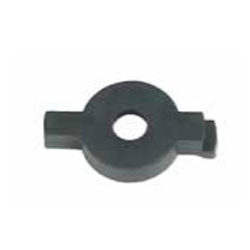
-
Besson
Cornet/Tenor Horn Valve Guide
Plastic valve guide for Besson cornets and tenor horns using an 11.5 mm winged guide. Sold individually—if replacing multiple guides, you will need to order multiple units. Fits these models:• 927 cornet
• 928 cornet
• 2028 cornet
• 950 tenor horn
• 2050 tenor hornDimensions:
• 11.5 mm diameter
Category: Trumpet Replacement Parts
Item: 139458
Grade:
List Price:
OUR PRICE: $4.00
Availability: Ships in 10 to 15 Days - View Shopping Cart
-

-
Conn C-63664-7
Trumpet Valve Spring Set
Factory replacement valve springs. Three springs.NOTE: Image shown is generic and may not accurately represent this exact item.
Category: Trumpet Replacement Parts
Item: 076531
Grade:
List Price:
OUR PRICE: $5.99
Availability: Usually Ships in 24 Hours - View Shopping Cart
-
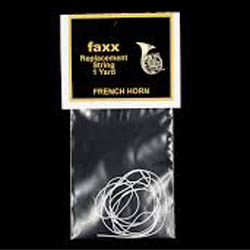
-
Faxx
Rotor Valve String
Special grade string is made specifically for restringing rotary valves of all sizes. For trumpet, french horn, trombone, bass trombone, euphonium & tuba. 36" length.
Category: Brass Replacement Parts
Item: 123678
Grade:
List Price:
OUR PRICE: $2.50
Availability: Usually Ships in 24 Hours - View Shopping Cart
-
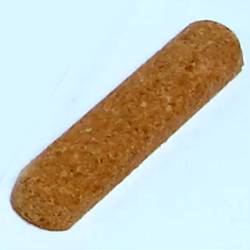
-
Ferree's
Mute Cork, Large
Rubberized cork suitable for replacing the cork on all brands of straight & cup mutes, as well as Jo-Ral brand bucket mutes. Large size is appropriate for trombone & bass trombone mutes. Sold singly. If you are replacing all three, please order three.Approximate Dimensions: 2-3/8 x 1/2 x 13/64 inches thick (6 x 1.25 x 0.5cm).
Category: Brass Replacement Parts
Item: 035586
Grade:
List Price: $4.60
OUR PRICE: $3.75
Availability: Usually Ships in 24 Hours - View Shopping Cart
-
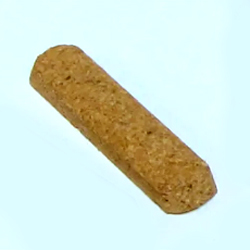
-
Ferree's
Mute Cork, Small
Rubberized cork suitable for replacing the cork on all brands of straight & cup mutes, as well as Jo-Ral brand bucket mutes. Small size is appropriate for trumpet & horn mutes. Sold singly. If you are replacing all three, please order three.Approximate Dimensions: 1-7/8 x 3/8 inches (4.75 x .95 cm)
Category: Brass Replacement Parts
Item: 035585
Grade:
List Price: $4.60
OUR PRICE: $3.75
Availability: Usually Ships in 24 Hours - View Shopping Cart
-

-
Getzen
Trumpet 3rd Valve Push Rod w/Finger Ring & Nib
Third valve thumb ring with stopping nib on the underside. On many trumpets, the nib will collide with the end of third valve outer slide, preventing the inner slide and end crook from falling off the instrument when fully extended. Rod is 1/8 inch square and 3 inches in length.
Category: Trumpet Replacement Parts
Item: 132991
Grade:
List Price: $30.50
OUR PRICE: $25.00
Availability: Usually Ships in 24 Hours - View Shopping Cart
-
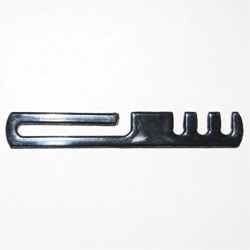
-
Getzen
Trumpet 3rd Valve Slide Stop, Plastic
Fit Getzen and other similar-built trumpets. Prevents 3rd valve slide from falling off the horn. Black plastic construction.
Category: Trumpet Replacement Parts
Item: 125082
Grade:
List Price:
OUR PRICE: $6.00
Availability: Usually Ships in 24 Hours - View Shopping Cart
-
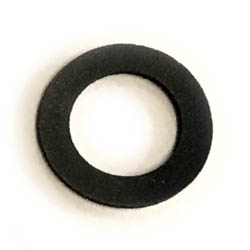
-
Getzen
Trumpet Top Cap Pad (Rubber)
Rubber pad used in the top cap on Getzen trumpets and cornets. Self adhesive backing. Specs:• 11/16-inch outer diameter
• 7/16-inch inner diameter
• 1/16-inch (1.6 mm) thick
Category: Trumpet Replacement Parts
Item: 132825
Grade:
List Price:
OUR PRICE: $1.50
Availability: Usually Ships in 24 Hours - View Shopping Cart
-

-
Getzen A1659
Trumpet Slide Bumper Ring
Rubber ring that slides over inner trumpet slide to act as bumper - for example on third valve slide.
Category: Trumpet Replacement Parts
Item: 134156
Grade:
List Price:
OUR PRICE: $0.25
Availability: Usually Ships in 24 Hours - View Shopping Cart
-

-
Holton
Trumpet Valve Guide - 2 sided
A 2-sided valve guide used on certain Holton trumpets such as the T101, 103, 302 and 306. Certain 602 models that don't use the round valve guide use this one instead.
Category: Trumpet Replacement Parts
Item: 133068
Grade:
List Price:
OUR PRICE: $3.00
Availability: Ships in 10 to 15 Days - View Shopping Cart
-

-
Holton
Trumpet Valve Guide - round
The round valve guides used on many Holton trumpets and cornets.
Category: Trumpet Replacement Parts
Item: 133067
Grade:
List Price:
OUR PRICE: $9.79
Availability: Ships in 10 to 15 Days - View Shopping Cart
-
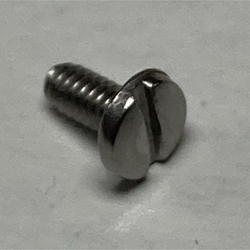
-
Holton H296
Rotor Valve Armature String Screw
Small slotted screw that holds the string in place on Holton brand rotor armatures. This is the screw where the string loops around. One required per rotary valve. 4.5mm wide cap. 6.3mm overall length..
Category: Brass Replacement Parts
Item: 125698
Grade:
List Price:
OUR PRICE: $0.99
Availability: Usually Ships in 24 Hours - View Shopping Cart
-

-
JLS
Water Key Corks, Assorted (24)
Set of 24 assorted sized water key corks to fit all makes and models of trumpets, cornets, trombone , baritones, and euphoniums. Former Valentino brand.
Category: Brass Replacement Parts
Item: 047817
Grade:
List Price: $30.70
OUR PRICE: $24.95
Availability: Ships in 10 to 15 Days - View Shopping Cart
-
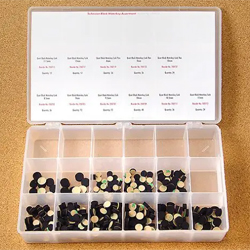
-
JLS
Water Key Pad Technician Assortment
JLS Black Waterkey Corks are synthetic peel-and-stick waterkey cork seals. Former Valentino brand. • Standard Waterkey Corks are 4.6mm (.180") thick. • Thin Waterkey Corks are 3.4mm (.135") thick. Advantages: • The main advantage of using synthetic v. natural cork is that synthetic cork won't deteriorate over time from water and saliva. • Synthetic waterkey corks are much easier to install due to their peel-and-stick adhesive backing. • ...
Read More
Category: Brass Replacement Parts
Item: 139571
Grade:
List Price: $200.00
OUR PRICE: $169.99
Availability: Ships in 10 to 15 Days - View Shopping Cart
-
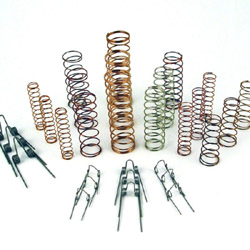
-
JLS Director's
Brass Instrument Spring Replacement Kit
This brasswind spring assortment will keep your brasses playing when their "springs are sprung." A convenient item for any Band Director or Marching Program to have. Contains 18 piston valve springs for high brass and low brass, plus 12 to 15 water key springs of various types and sizes. Former Valentino brand. • 3 tuba • 3 medium-heavy euph/baritone • 3 medium-light euph/baritone • 3 medium-heavy trumpet • 3 medium-light trumpet •...
Read More
Category: Brass Replacement Parts
Item: 128933
Grade:
List Price: $61.00
OUR PRICE: $43.99
Availability: Usually Ships in 24 Hours - View Shopping Cart
-

-
John Packer
Rotor Valve Bumper Plate Screw
Small screw for used to attach the rotor valve stop plate to the valve housing. The stop plate is the part that holds the two rubber or cork bumpers. Two screws are required for a complete installation. Used on various John Packer instruments with rotaryvalves. Sold as a single screw.
Category: Brass Replacement Parts
Item: 125702
Grade:
List Price:
OUR PRICE: $5.89
Availability: Usually Ships in 24 Hours - View Shopping Cart
-

-
John Packer
Rotor Valve Stop Arm Retaining Screw
Screw used to attach the rotor stop arm to the rotor shaft. Used on various John Packer rotary valve instruments, including horns, trombones, bass trombones & tubas.The Stop Arm (also known as the Armature) is the piece that connects to the rotor shaft and moves the rotor back and forth. This screw holds it in place.
Category: Brass Replacement Parts
Item: 125701
Grade:
List Price:
OUR PRICE: $6.55
Availability: Ships in 10 to 15 Days - View Shopping Cart
More Options
- Use our Custom Order Page to special order items you can't find.
- Use our Catalog Order Page to order items from a printed catalog, or if you already know our catalog number for the item(s) you're interested in.
- And as always, feel free to E-mail us with your questions!
